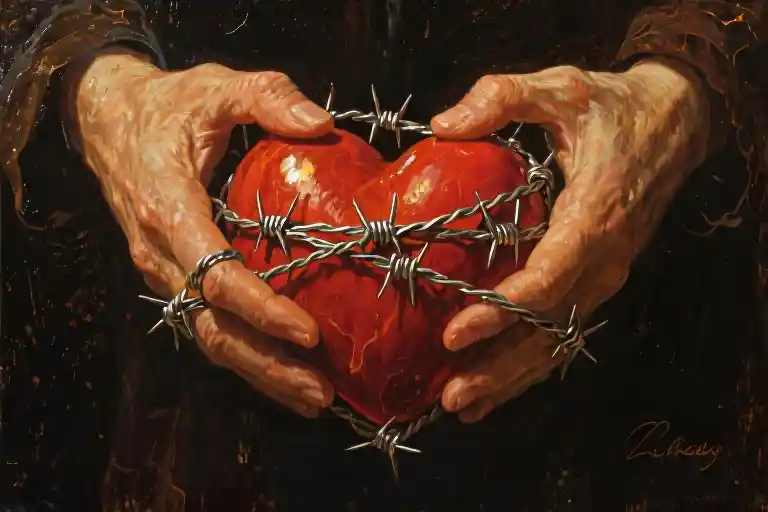They said he was trouble, but trouble had a way of looking beautiful in the beginning. Like lightning captured in a photograph—all dazzling streaks against a dark sky before you remember it’s the same force that reduces trees to charcoal. That’s how toxic relationships often start: wrapped in golden-hour glow, their sharp edges softened by the magic hour light.
Have you ever mistaken urgency for passion? That frantic pulse in your chest when someone makes every moment feel like the last train leaving the station? We’re wired to confuse the two—our brains lighting up the same reward pathways whether we’re running toward love or away from danger. It’s no accident that the word ‘intoxication’ describes both chemicals and infatuation.
This is how beautiful danger reveals its teeth. First comes the gilded phase, where even red flags look romantic waving in sunset light. Then the slow unraveling, where you’re patching holes in someone else’s boat while yours takes on water. Finally, the moment you recognize those silver moons he’s been twisting from bottle caps aren’t keepsakes—they’re the shrapnel left after emotional detonations.
The most dangerous lovers don’t arrive with warning labels. They come carrying mystery like a bouquet, their inconsistencies mistaken for depth. You’ll notice his hands never stay still—fidgeting with poker chips, drumming on tabletops, tracing circles on your wrist like he’s memorizing the path to your pulse points. Later, you’ll understand this isn’t charm; it’s the tremors of someone who can’t sit with their own thoughts.
What makes these relationships so hard to quit isn’t just the person—it’s the story we tell ourselves about them. The narrative where our love could be the exception, the magic balm that finally soothes their restlessness. We ignore the fundamental truth: some people aren’t looking for anchors. They want witnesses to their burning.
In the coming sections, we’ll walk through the three acts of these emotional thrillers—from the gilded masks to the drifting boats to those telltale silver moons. Not to scare you, but to give language to what your nervous system already knows. Because the greatest protection isn’t skepticism; it’s learning to distinguish between lightning and light.
Golden Hour: When Danger Wears Gilded Masks
The most dangerous kind of attraction often arrives wrapped in golden light. That initial phase when his smile hasn’t yet shown its sharp edges, when every word feels like a secret meant just for you. Neurologists call this the dopamine delusion – our brains chemically reward us for pursuing unpredictable rewards, which explains why warning signs feel exhilarating rather than alarming during those first encounters.
His hands never stayed still. Fingers drumming tabletops, shuffling poker chips, tracing invisible patterns on your wrist. That constant motion activates our mirror neurons, creating false intimacy. What we interpret as passionate energy often masks deeper instability. The same neurological wiring that makes us lean closer when someone whispers also makes us dismiss red flags wrapped in pretty packaging.
Urgency is the first language toxic relationships speak fluently. ‘We have to do this now’ feels romantic when really, it’s emotional time pressure working overtime. Healthy connections develop gradually; trauma bonds demand immediate intensity. That racing heartbeat when he says ‘nobody understands me like you do’ isn’t passion – it’s your nervous system sensing danger but getting the signals crossed.
Three warning signs hiding in plain sight during the golden hour:
- The schedule shift – plans always happen on his timeline, with explanations that sound thrillingly mysterious (‘I can’t explain now, just trust me’)
- The compliment sandwich – extravagant praise layered between subtle digs (‘You’re so mature… most girls can’t handle my lifestyle… but you’re different’)
- The future fake – detailed fantasies about trips you’ll take, homes you’ll buy, while dodging simple present commitments (‘Let’s not label things yet’)
Your golden hour checklist:
- Do quiet moments feel uncomfortable, like you’re waiting for the next ‘high’?
- Are you rationalizing behaviors that would concern you if a friend described them?
- Does the story keep changing, with inconsistencies explained as ‘you misunderstanding’?
That gilded beginning serves a biological purpose – it’s the bait our trauma patterns recognize fastest. The trick isn’t blaming yourself for biting, but learning to taste the difference between golden and real.
The Drifting Boat Theory of One-Sided Love
She thought love was about keeping someone else afloat while her own lifeboat took on water. This particular delusion has sunk more relationships than icebergs ever did. The compulsion to fix broken people isn’t altruism – it’s a sophisticated form of self-abandonment dressed in heroic clothing.
Cultural mythology feeds this fantasy. From Beauty and the Beast to a thousand romantic comedies, we’re taught that unconditional love can transform damaged souls. The narrative insists that if you pour enough kindness into someone, they’ll eventually overflow with gratitude and change. But psychology reveals a darker truth: the more you patch someone else’s leaks, the more they’ll rely on your buckets while never learning to swim.
Behavioral economists call this the sunk cost fallacy of relationships. The longer we invest in a failing dynamic, the harder it becomes to walk away – not because the situation improves, but because admitting failure would mean all those sleepless nights and swallowed tears were wasted. We confuse endurance with virtue, mistaking our growing exhaustion for deepening commitment.
Watch for these three lifeboats you might be clinging to:
- The Translation Treadmill – Believing if you just explain your needs perfectly, they’ll finally understand (they won’t)
- The Memory Life Preserver – Holding onto who they were in the beginning rather than who they’re showing you now
- The Potential Parachute – Banking on some future version of them that never actually arrives
The cruel irony? The very qualities that make someone good at repairing others – empathy, patience, emotional labor – are the same traits that prevent them from recognizing when they’re being used as human flotation devices. You keep caulking their cracks with your compassion until one day you look up and can’t see the shore anymore.
Here’s what the fairy tales don’t tell you: Some boats aren’t meant to be saved. Some people prefer the drama of sinking to the work of bailing. And no amount of love can change someone who’s in love with their own destruction.
The healthiest love doesn’t ask you to choose between keeping someone else dry and drowning yourself. Real connection happens when two whole people choose to sail together – not when one becomes the other’s permanent repair crew.
Anatomy of a Silver Moon
The bottle cap between his fingers kept turning, flattening, turning again – tiny silver moons born and crushed in the span of a breath. This was the language he spoke when words failed: restless hands sketching anxiety in the air. You might have mistaken it for charm at first, that fidgety creativity. Until you noticed the pattern – how every object within reach became a casualty of his nervous energy, twisted beyond recognition.
Psychologists call these manipulative mannerisms – not in the sinister sense, but as literal manipulations of physical space. The crumpled bills counted and recounted. Cards shuffled long after the game ended. These aren’t just habits; they’re distress signals written in kinetic code. When someone lives perpetually between almost and never, their body often betrays what their words won’t confess. The hands move precisely because the future won’t.
I once interviewed a woman who recognized her partner’s destructive spiral through these micro-gestures. The night I knew, she recalled, was when he peeled the label off his beer bottle in one continuous strip. Not casually, but with surgical focus – like if he could control this one perfect curl of paper, maybe our crumbling life would hold its shape. Her story echoes the research: compulsive object manipulation frequently correlates with emotional avoidance. The hands busy themselves so the heart won’t have to.
What makes these silver moons so treacherous is their duality. On good days, they passed for endearing quirks – proof of a restless creative mind. But trauma bonds often form in these ambiguities, where warning signs masquerade as personality traits. The difference between a nervous habit and a red flag? Consistency. One is occasional; the other is compulsive. One relieves stress; the other manufactures it.
Survivors describe the turning point differently. For some, it was realizing they’d memorized the texture of every twisted bottle cap. For others, the moment their own hands started mimicking those restless patterns. The most poignant account came from a woman who found her toddler trying to fold a gum wrapper into tiny squares: That’s when I saw the fire wasn’t just his to burn in.
Recovery begins with translating these physical metaphors. That twist of the wrist isn’t just a tic – it’s a silent manifesto. The way someone handles objects often reveals how they’ll handle hearts. And silver moons, however beautifully tragic, still cut like broken glass when held too tight.
When Lightning Becomes Fire
That first strike always looks like art. The way it fractures the sky in jagged gold, how the air hums with possibility seconds before you smell ozone. We mistake beauty for safety all the time—the curve of a smile hiding serrated edges, hands that craft silver moons from bottle caps while counting escape routes in crumpled bills.
Here’s what no one tells you about toxic relationships: they don’t start with warning signs. They start with your own heartbeat syncing to someone else’s broken rhythm, thinking you can conduct the chaos into melody. You’ll memorize the wrong lyrics first—when he says ‘we have tonight,’ you hear ‘forever.’ When his fingers trace your wrist like counting prayer beads, you don’t notice he’s measuring your pulse points.
Three questions survivors wish they’d asked earlier:
- Does this urgency feel like wings or shackles?
- Am I repairing or replacing myself?
- What exactly is burning in his golden hour light?
Those silver moons he leaves everywhere—twisted bottle caps, car keys bent from anxious fidgeting, promises folded too small to unfold—they’re not souvenirs. They’re the breadcrumbs you’ll need to find your way back when the fire he’s building consumes your maps. The terrible truth about people who live between almost and never? They don’t want company in the flames. They want witnesses.
So let’s take our metaphors to the clinic:
- Lightning as art = trauma bonding’s first high
- Boat patching = codependency’s false algebra (their wounds + your care = wholeness)
- Silver moons = the micro-behaviors of emotional arson (DSM-5 would call this ‘maladaptive coping’ but poetry calls it clearer)
Before you go, try this: hold your hands very still. Notice where the tremors come from—his absence or your presence? Some fires need tending. Others require walking away while your shoes still have soles. The forest always grows back. Not where the lightning struck, but close enough.





